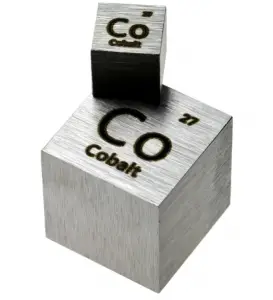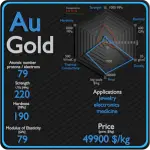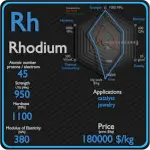This article contains comparison of key thermal and atomic properties of cobalt and silver, two comparable chemical elements from the periodic table. It also contains basic descriptions and applications of both elements. Cobalt vs Silver.

Cobalt and Silver – About Elements


Source: www.luciteria.com
Cobalt and Silver – Applications
Cobalt
Cobalt has been used in many industrial, commercial, and military applications. Cobalt is primarily used in lithium-ion batteries, and in the manufacture of magnetic, wear-resistant and high-strength alloys. Cobalt-based Superalloys. This class of alloys is relatively new. In 2006, Sato et al. discovered a new phase in the Co–Al–W system. Unlike other superalloys, cobalt-base alloys are characterized by a solid-solution-strengthened austenitic (fcc) matrix in which a small quantity of carbide is distributed. While not used commercially to the extent of Ni-based superalloys, alloying elements found in research Co-based alloys are C, Cr, W, Ni, Ti, Al, Ir, and Ta. They possess better weldability and thermal fatigue resistance as compared to nickel based alloy. Moreover, they have excellent corrosion resistance at high temperatures (980-1100 °C) because of their higher chromium contents. Several cobalt compounds are oxidation catalysts. Typical catalysts are the cobalt carboxylates (known as cobalt soaps). They are also used in paints, varnishes, and inks as “drying agents” through the oxidation of drying oils.
Silver
Silver has long been valued as a precious metal. Silver metal is used in many bullion coins, sometimes alongside gold. Silver has many important, far-reaching technological and electronic applications. It’s used in everything from cell phones, computers and semiconductors to automobiles, water-purification systems and—because it is the best conductor of heat of all elements—spacecraft solar radiation tiles. Silver is of the upmost importance in photography (where approximately 30% of the U.S. Industrial consumption goes into this application). The medical uses of silver include its use in wound dressings, creams, and as an antibiotic coating on medical devices. Wound dressings containing silver sulfadiazine or silver nanomaterials may be used on external infections.
Cobalt and Silver – Comparison in Table
| Element | Cobalt | Silver |
| Density | 8.9 g/cm3 | 10.49 g/cm3 |
| Ultimate Tensile Strength | 800 MPa | 110 MPa |
| Yield Strength | 220 MPa | 45 MPa |
| Young’s Modulus of Elasticity | 209 GPa | 83 GPa |
| Mohs Scale | 5 | 3.25 |
| Brinell Hardness | 800 MPa | 210 MPa |
| Vickers Hardness | 1040 MPa | 251 |
| Melting Point | 1495 °C | 961.78 °C |
| Boiling Point | 2927 °C | 2162 °C |
| Thermal Conductivity | 100 W/mK | 430 W/mK |
| Thermal Expansion Coefficient | 13 µm/mK | 18.9 µm/mK |
| Specific Heat | 0.42 J/g K | 0.235 J/g K |
| Heat of Fusion | 16.19 kJ/mol | 11.3 kJ/mol |
| Heat of Vaporization | 376.5 kJ/mol | 250.58 kJ/mol |













